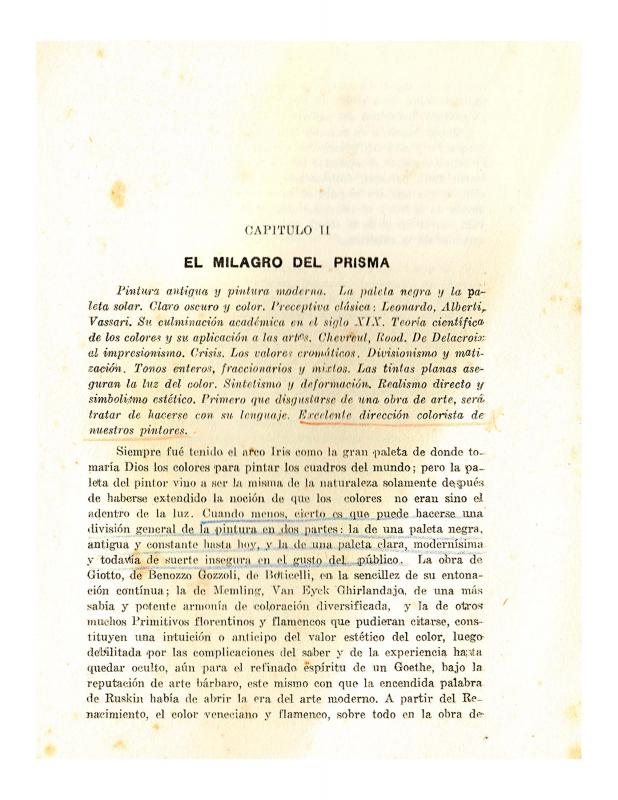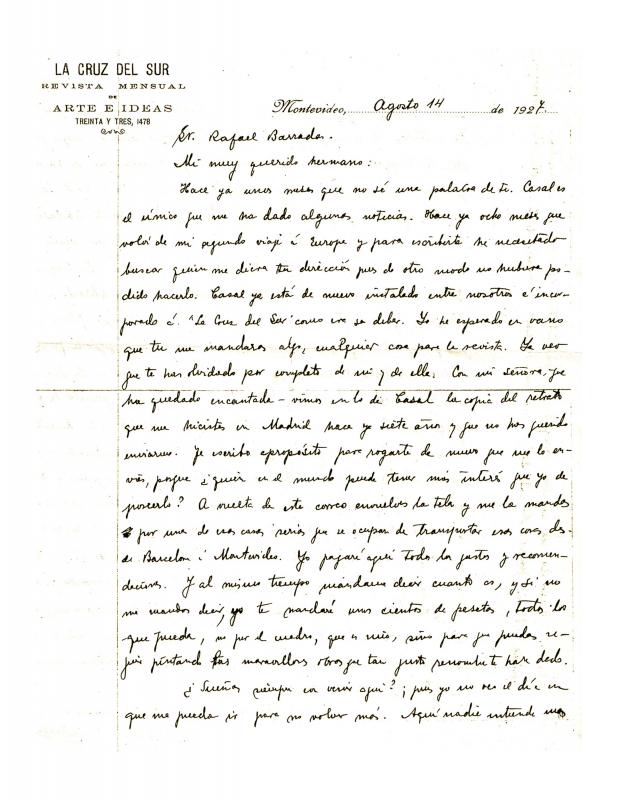Founded in 1923 under the direction of the writer Eduardo Dieste (1881−1954), the association Teseo was a group of Uruguayan artists and writers that exerted notable influence in local Montevideo circles at the time. The director played a significant role as producer and disseminator of ideas about the visual arts in Uruguay during the 1920s. The publication by Teseo was intended to disseminate aspects that involved and affirmed traditional theoretic by leading European thinkers with a contemporary look toward Uruguay. The book Teseo Discusión Estética y Ejemplos was written by Dieste, the director of Teseo at the time. Eduardo Dieste was a critic, writer, and cultural activist of significant importance within the country during the twenties. The volume begins with the long chapter titled “El drama de la pintura,” presenting those elements that were the characters of drama, in his opinion that are light, color, and form, the triad that he considered were in permanent conflict throughout the history of art and throughout its development. He cites the theoretical work of artists such as Leonardo da Vinci (1452−1519), although he especially supported the ideas of John Ruskin (1819−1900), who had been an inspiration for modern landscape artists, and artists such as Joseph William Turner (1775−1851), a critic of the social effects of the industrial revolution and a defender of aesthetic ideas that attempted to define “cultural identity” in symbolic terms. During the time that Dieste is disseminating the ideas of the English critic, he displays his own opinions that were of a cultivated nativism with a basis in European culture, either like those seen in Impressionism, a great antecedent needing the recovery of light, or to those who praised the techniques and approaches used by Paul Gauguin (1848−1903) in his planar forms and rich colors. As suggested before, Dieste established a relationship where these findings and ideas were put into practice by the Uruguayan artists of the time. At first, he references and places at the head of his list, names of José Cuneo (1887−1977) whose work he promoted, and he also referenced the work of Carmelo de Arzadun (1888−1968), and Humberto Causa (1890−1925), as they have pursued approaches to landscape that referred to a compositional synthesis and a “flat surface covered with colors deducted from the real ones.” Light and color acquire the character of a self-indulgent euphoric affirmation and interpretation of its time, typical of the twenties, which Dieste and Teseo assisted in originating. The document is a manifesto revealing the significant value the author gives to the changes taking place in art history especially in relation to the dramatic role played by light, color, and forms after the dissolution of Impressionism. The promotion of Uruguayan artists whom Dieste promoted and defended for their protagonist role in Teseo (then on travel grants to Europe) in which the artists were impacted by these influences, synthesizing them into innovative creations. The document reveals the proper relational harmony between the new art in Uruguay and the changes in European art relating to a certain formal synthesis and the treatment of light. In this sense, the text of Dieste is a good example of the dynamics that was being disseminated throughout Uruguay in the art world during the twenties, a decade marked by optimism, based on the acceptance of external models that were adapted and improved upon, but that had an undeniable connection to “the local.” [For further reading, please refer to the ICAA digital archive for the following texts published by the Teseo (la Agrupación de Artistas y Escritores Uruguayos/The Unión of Uruguayan Artists and Writers) and by Eduardo Dieste himself: “Bernabé Michelena, escultor” (doc. no. 1220780), “Humberto Causa, otro pintor de la luz” (doc. no. 1221130), “José Cuneo Pintor de la luz” (doc. no. 1217703), and “El Milagro del Prisma [Teseo Discusión Estética y ejemplos]” (doc. no. 1217097). Additionally see: “Boletín de Teseo [Agrupación de Artistas y Escritores Uruguayos],” by José Cuneo, Bernabé Michelena, et. al., (doc. no. 1182637), “Carta a Rafael Barradas” (doc. no. 1250919), “De la invención en la pintura” (doc. no. 1245854), and “Escuela Taller de Artes Plásticas al Ministro de Instrucción Pública [carta institucional en borrador],” by the ETAP (Escuela Taller de Artes Plásticas) (doc. no. 1265434), and also “Primer Grupo Argentino de Pintores Modernos” (doc. no. 1228165) and “Programa” by Alberto Zum Felde (doc. no. 1196932), “Teseo; Los Problemas del Arte,” by C.L. (doc. no. 1223765), and “Uruguay Olímpico,” by Alberto Lasplaces (doc. no. 1254039)].











